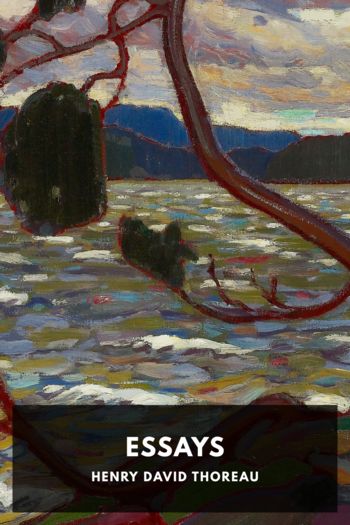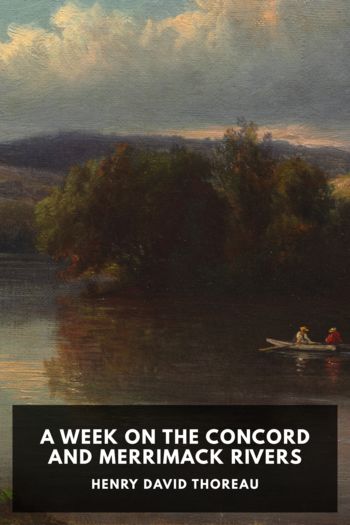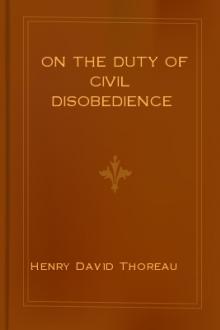Essays by Henry David Thoreau (feel good books .txt) 📕

Description
Though perhaps most famous for Walden, Henry David Thoreau was also a prolific essayist. Many of his essays touch on subjects similar to his famous book: long walks through nature, things found in moonlight that are invisible and unheard during the day, his preference for wild apples over domestic ones. In many ways he prefigured environmentalism, expressing his love for untouched nature and lamenting what the encroachment of man and cities were doing to it.
He also had strong opinions on many other subjects. One of his most famous essays, “On the Duty of Civil Disobedience,” was written as a result of his going to jail for refusing to pay several years’ worth of poll taxes. One of the primary reasons for his refusal was his holding the government in contempt for its support of slavery, and several of his other essays express support and admiration for John Brown, who thought to start a slave revolt when he attacked Harper’s Ferry in 1859.
Whether discussing trees in a forest, slavery, or the works of Thomas Carlyle, Thoreau’s essays are deeply personal and full of keen observations, often in poetic language. They give a sense of the man expressing them as being much more than the views being expressed.
Read free book «Essays by Henry David Thoreau (feel good books .txt) 📕» - read online or download for free at americanlibrarybooks.com
- Author: Henry David Thoreau
Read book online «Essays by Henry David Thoreau (feel good books .txt) 📕». Author - Henry David Thoreau
At the same time with this, or near the end of August, a to me very interesting genus of grasses, Andropogons, or beard-grasses, is in its prime. Andropogon furcatus, forked beard-grass, or call it purple-fingered grass; Andropogon scoparius, purple wood grass; and Andropogon (now called Sorghum) nutans, Indian-grass. The first is a very tall and slender-culmed grass, three to seven feet high, with four or five purple finger-like spikes raying upward from the top. The second is also quite slender, growing in tufts two feet high by one wide, with culms often somewhat curving, which, as the spikes go out of bloom, have a whitish fuzzy look. These two are prevailing grasses at this season on dry and sandy fields and hillsides. The culms of both, not to mention their pretty flowers, reflect a purple tinge, and help to declare the ripeness of the year. Perhaps I have the more sympathy with them because they are despised by the farmer, and occupy sterile and neglected soil. They are high-colored, like ripe grapes, and express a maturity which the spring did not suggest. Only the August sun could have thus burnished these culms and leaves. The farmer has long since done his upland haying, and he will not condescend to bring his scythe to where these slender wild grasses have at length flowered thinly; you often see spaces of bare sand amid them. But I walk encouraged between the tufts of purple wood-grass, over the sandy fields, and along the edge of the shrub-oaks, glad to recognize these simple contemporaries. With thoughts cutting a broad swathe I “get” them, with horse-raking thoughts I gather them into windrows. The fine-eared poet may hear the whetting of my scythe. These two were almost the first grasses that I learned to distinguish, for I had not known by how many friends I was surrounded—I had seen them simply as grasses standing. The purple of their culms also excites me like that of the pokeweed stems.
Think what refuge there is for one, before August is over, from college commencements and society that isolates! I can skulk amid the tufts of purple wood-grass on the borders of the “Great Fields.” Wherever I walk these afternoons, the purple-fingered grass also stands like a guide-board, and points my thoughts to more poetic paths than they have lately travelled.
A man shall perhaps rush by and trample down plants as high as his head, and cannot be said to know that they exist, though he may have cut many tons of them, littered his stables with them, and fed them to his cattle for years. Yet, if he ever favorably attends to them, he may be overcome by their beauty. Each humblest plant, or weed, as we call it, stands there to express some thought or mood of ours; and yet how long it stands in vain! I had walked over those great fields so many Augusts, and never yet distinctly recognized these purple companions that I had there. I had brushed against them and trodden on them, forsooth; and now, at last, they, as it were, rose up and blessed me. Beauty and true wealth are always thus cheap and despised. Heaven might be defined as the place which men avoid. Who can doubt that these grasses, which the farmer says are of no account to him, find some compensation in your appreciation of them? I may say that I never saw them before—though, when I came to look them face to face, there did come down to me a purple gleam from previous years; and now, wherever I go, I see hardly anything else. It is the reign and presidency of the Andropogons.
Almost the very sands confess the ripening influence of the August sun, and methinks, together with the slender grasses waving over them, reflect a purple tinge. The impurpled sands! Such is the consequence of all this sunshine absorbed into the pores of plants and of the earth. All sap or blood is now wine-colored. At last we have not only the purple sea, but the purple land.
The chestnut beard-grass, Indian-grass, or wood-grass, growing here and there in waste places, but more rare than the former (from two to four or five feet high), is still handsomer and of more vivid colors than its congeners, and might well have caught the Indian’s eye. It has a long, narrow, one-sided, and slightly nodding panicle of bright purple and yellow flowers, like a banner raised above its reedy leaves. These bright standards are now advanced on the distant hillsides, not in large armies, but in scattered troops or single file, like the red men. They stand thus fair and bright, representative of the race which they are named after, but for the most part unobserved as they. The expression of this grass haunted me for a week, after I first passed and noticed it, like the glance of an eye. It stands like an Indian chief taking a last look at his favorite hunting-grounds.
The Red MapleBy the twenty-fifth of September, the red maples generally are beginning to be ripe. Some large ones have been conspicuously changing for a week, and some single trees are now very brilliant. I notice a small one, half a mile off across a meadow, against the green wood-side there, a far brighter red than the blossoms of any tree in summer, and more conspicuous. I have observed this tree for several autumns invariably changing earlier than its fellows, just as one tree ripens its fruit earlier than another. It might serve to mark the season, perhaps. I should be sorry, if it were cut down. I know of two or three such trees in different parts of our town, which might, perhaps, be propagated from, as early ripeners or September trees, and their seed be advertised in the market, as well as that of radishes, if we cared as much about them.
At present





Comments (0)